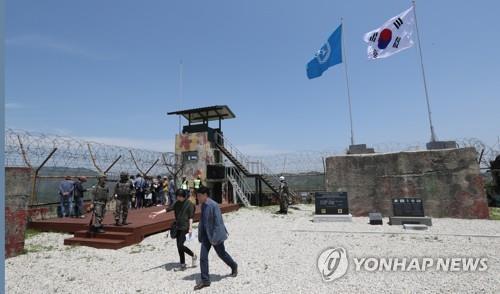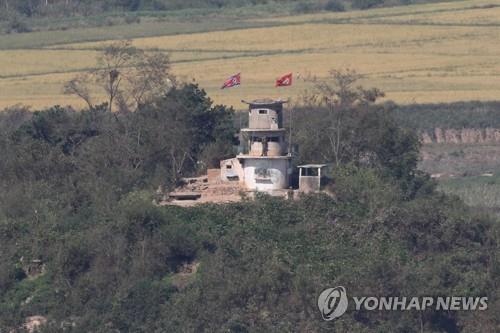- California Assembly OKs highest minimum wage in nation
- S. Korea unveils first graphic cigarette warnings
- US joins with South Korea, Japan in bid to deter North Korea
- LPGA golfer Chun In-gee finally back in action
- S. Korea won’t be top seed in final World Cup qualification round
- US men’s soccer misses 2nd straight Olympics
- US back on track in qualifying with 4-0 win over Guatemala
- High-intensity workout injuries spawn cottage industry
- CDC expands range of Zika mosquitoes into parts of Northeast
- Who knew? ‘The Walking Dead’ is helping families connect
UNC says it cannot determine whether N.K. started border gunfire accidentally
The United Nations Command (UNC) said Tuesday that it could not “definitively” determine whether North Korea started a recent exchange of gunfire with South Korea intentionally or by mistake but found that both sides violated the armistice agreement.
The U.S.-led command, which administers the Demilitarized Zone (DMZ) and enforces the armistice that halted the 1950-53 Korean War, came to the conclusion after a weekslong investigation into the May 3 incident, where four bullets from the North hit a South Korean guard post, leading South Korean troops to return fire.
According to the investigation, North Korea committed the violation as it fired four rounds of 14.5-millimeter small arms from its guard post located on the northern side of the inter-Korean border at a South Korean guard post.
“However, the investigation was unable to definitively determine if the four rounds were fired intentionally or by mistake,” UNC said in a release uploaded on its Facebook page.
The command invited the North Korean military to provide information on the case, and the North acknowledged receipt of the request. But it has not offered a formal response, UNC added.
South Korea also violated the armistice by responding “with two volleys of gunfire” toward North Korea, according to UNC.
“Based on the investigation’s comprehensive findings, UNC personnel will engage in follow-on discussions with both sides to encourage an implementation of measures to prevent a recurrence of Armistice violations,” the command said.
According to Article 1 of the agreement, neither side “shall execute any hostile act within, from, or against the demilitarized zone.”
South Korea’s defense ministry expressed regret that the UNC drew the conclusion without investigating North Korea and claimed that the South responded to the North’s gunfire appropriately in accordance with a response manual.
“Our military unit at the scene took appropriate measures … in accordance with a response manual,” the ministry said in a release. “We express regret that the results of this probe have been announced without a practical investigation of the North Korean military’s gunfire.”
“We will continue to fully implement the Sept. 19 military agreement and take other measures to ease military tensions and to promote peace on the Korean Peninsula,” the ministry said, citing the inter-Korean military pact signed in 2018.
Noting that the armistice agreement is meant to minimize the risk of incidents such as gunfire exchange, UNC said it will continue to identify and implement ways to improve conditions for peace and stability on the Korean Peninsula.


This photo, taken on May 22, 2019, shows a South Korean guard post inside the Demilitarized Zone (DMZ) in Cheorwon, Gangwon Province. (Pool photo) (Yonhap)
Following the incident, UNC dispatched a multinational special investigation team for a probe, which was observed by the Neutral Nations Supervisory Commission to ensure transparency and fairness, the command said, adding that the South Korean military fully cooperated with the investigation.
Earlier, South Korean military authorities said they believe the incident was not an intentional provocation based upon evidence secured from various intelligence sources.
U.S. Secretary of State Mike Pompeo also said on the day of the incident that he believes the incident was “accidental.”
The Joint Chiefs of Staff said earlier that the South Korean troops fired about 15 rounds with a K-3 machine gun at the North Korean guard post.
Upon learning that the North used a 14.5-millimeter anti-aircraft machine gun, however, the South fired another 15 rounds with a 12.7-mm K-6 heavy machine gun “in accordance with the principle of proportional responses.”
Right after the gunfire, South Korea sent a notice to the North and called for an explanation, but Pyongyang remains mum on the issue.
It was the first exchange of gunfire between South and North Korea in years. Under the Comprehensive Military Agreement signed in September 2018, the two Koreas agreed to halt all hostile acts against each other, a move aimed at reducing tensions and building trust.
The DMZ, which is about 250 kilometers long and 4 km wide, is one of the world’s most heavily fortified borders and has often been a flashpoint between the rival Koreas, though South Korea has been pushing to turn it into a global peace zone.








![일본 사도광산 [서경덕 교수 제공. 재판매 및 DB 금지]](http://www.koreatimesus.com/wp-content/uploads/2024/07/PYH2024072610800050400_P4-copy-120x134.jpg)


